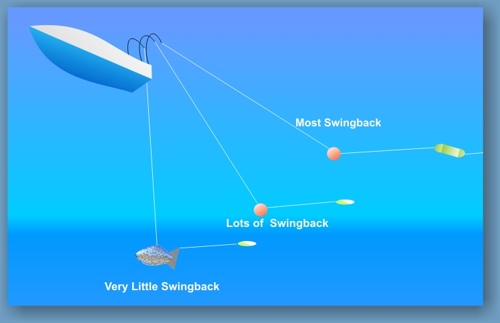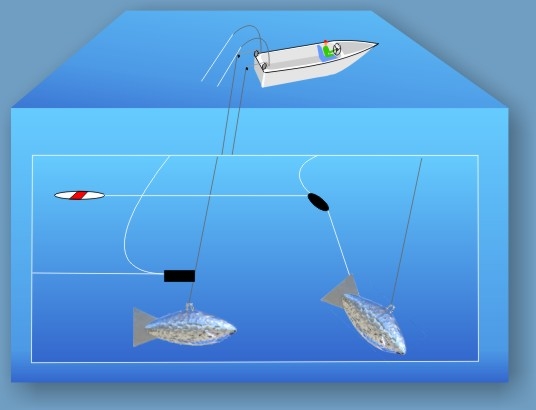

Salmon are interested in one thing:
Baitfish !!!
and they use sound to locate them !
It's called Passive Acoustics !
Baitfish make a lot of noise. Thats how salmon are able to find them.
Shark Cannonballs and Shark Spoons make a lot of noise: Thats how salmon are able to find them.
Passive acoustics is a term scientists use to describe the ability of predator fish like salmon to locate prey over great distances through the use of low frequency sound. Low frequency sound is known to travel for great distances underwater, it can move around undersea mountains and continue along on its path. In nature, elephants, whales and alligators are known to communicate with each other over long distances by using low frequency or infrasound.
It is a scientific fact salmon are only able to hear noise in the low frequency range, below 200Hz. By coincidence, it is also a scientific fact baitfish make low frequency noise when they swim. The muscle attached to their air bladder stretches it from side to side as the baitfish moves forward causing it to make a drum like thumping noise. Sound travels underwater at 4500 feet per second; almost a mile in one second. Salmon are able to hear the sound made by even a single baitfish; the thunderous sound generated by a school of baitfish is like a giant dinner bell to them. This ability has been the key to the survival of the salmon species over the past million years; it is the only way they can find food over great distances.
Noise is created underwater by oscillating cycles of compression and decompression of water. The phenomenon is known as vortex shedding. Water traveling over the troughs and edges of the facets is compressed and decompressed in an oscillating cycle; this is what gives the Shark its unique sonic signature.
It is therefore sound that attracts salmon to the Shark Cannonball and causes them to behave so aggressively around it. In nature, when predator fish like salmon encounter a school of bait fish, they corral the school into a tight bait ball by swimming circles around it. Salmon swim in circles around the Shark for the same reason: they think it is the bait ball.
Sound is the reason why salmon are attracted to the Shark Cannonball: they can hear it from a long way off. When they move in for the kill and get close to a Shark, the other factors such as light reflection, static discharge and vortex all converge to create additional stimulation causing the fish to strike the trailing lure.
We have compared the facetted Shark and the plain Shark for many years: Its no contest,. statistically, the facetted model works ten times better than the plain Sharks.
Most attractors work well when there are lots of fish around; the really good attractors bring in fish when the bite is down. Thousands of charter captains around the world have relied on the Shark for the past nine years to make their living. When nothing else is working, they know they can trust the Shark.
All game fish have a lateral line running down each side of their bodies serving as their primary method of finding food in the murky depths. This amazing sensory system is packed with electro and mechanical receptors that are able to pick up a wide range of faint underwater signals from great distances. Some scientists believe a salmon can detect the heartbeat of a baitfish at two hundred feet. The facets on the Shark generate signals specifically designed to target the lateral lines of salmon and other game fish.
In nature, when predator fish encounter a school of baitfish, they immediately start circling the school, drawing them into a densely packed bait ball. They will then charge through the ball devouring as many fish as they can. Charter captains from around the world have watched the underwater videos of the encounters between the Chrome Shark and the salmon, and have commented their excited behaviour is remarkably similar to the way salmon behave when they encounter a school of baitfish. They have concluded the most reasonable explanation for this phenomenon is that the salmon must think the facetted Shark is a school of baitfish.

Your cannonball should stay right under your boat where you can see it on your video screen. You must be able to place your lure at the exact depth you mark individual fish. The problem with the round ball is they swing back so far your transducer can't pick them up. Then you are just shooting blind. The angle theory isn't going to help you because you don't know the direction and speed of the currents down there. Wrong depth - No Fish! Sharks have less swing back, they stay right under your boat where you can see them! Place them at exactly the depth you are marking fish every time!
On good days, when the fish are plentiful, anything and everything will work. When the fishing slows down, and you have to hunt down every fish! Thatís when the Pros turn to Sharks! The superior tracking ability of the Shark allows you to turn hard for a quick second pass without crossing your lines. Run a tight figure eight pattern using short leads until those fish are in the box!
Experienced fishermen know that fish prefer different lures on different occasions. On most days the simple and elegant method of pulling a spoon 3 or 4 feet behind a Shark works just fine. A good fishermen however, must be prepared for the days when the fish would rather hit something else. Some people have good results with cut bait. Many people catch fish by using a flasher or a dodger to put action on a trolling fly. One important thing to remember is that THE SHARK IS AN ATTRACTOR. If you use it to pull another attractor, the two will compete for the salmons attention. When a salmon becomes interested in a Shark, as they do for the most part, running a lure 20 or 30 feet down the road is not going to be a good option. Keeping your gear in a tight configuration will give the salmon the most exposure to your lure.


Attention: Please be advised never to mix Shark Cannonballs with any other brand of downrigger weights. Sharks are designed to pivot on the spot into the current when turning or encountering a change in the direction of the current. They will therefore not swing out. Other weights have substantially different tracking properties and will swing out and tangle with the Sharks. We do not advise mixing Sharks of different weights, they have slightly different tracking properties and may result in tangles.
We recommend any suitable release that can be attached to the cable just above the Shark. This will enable the Shark to perform the way it was designed; the Shark MUST BE ABLE TO PIVOT ON ITS AXIS so it can point its nose into the current just like a weather vane. Any release device attached to the tail of the Shark including Off Shore Releases or rubber bands will cause the Shark to mis-track! When you tighten up your line to put the bow in the rod, this applies tension directly to the tail causing it to lift straight up. The Shark will be traveling along doing a headstand. It gets worse; attached to two points, the Shark essentially becomes a fixed rudder not able to pivot. It will swing out wildly when a current hits it from the side. We discovered this when we fixed a video camera on the Shark itself as opposed to the lure.
Home - Superstore - Pro Staff - Shark News - Shark Videos - Contact Us